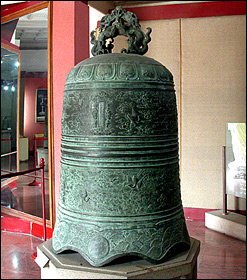 |
As a most admired bird in China, the crane is regarded as an
auspicious pattern and lofty symbol. During the Ming and Qing
dynasties, the decorative patch on an official robe carried a crane
pattern for the highest official rank. In the traditional bird
culture, the crane "has only one over him and millions under him,"
ranking second only to the phoenix. A respectable person was known
as "a figure extolled by the crane" and praised as an honest and
upright man. In the exhibition room of exquisite ancient bells, you
can find a Taoist bell with crane patterns. The body of the bell is
covered with patterns of 16 cranes flying above clouds or soaring
through clouds in different postures, presenting a beautiful
picture of cranes traveling in auspicious clouds. Cast in the reign
of Emperor Zhengde during the Ming Dynasty (1368- 1644), the bell
is 1.70 meters in height and 1,300 kilograms in weight. It has
close ties with Taoist immortals. The legend goes that immortals
usually ride on cranes and that "cranes are well- behaved like
gentlemen, incorruptible and naturally clean and honest; their
screams are resonant and they can be compared with outstanding
talents." The reason why the bell was cast with crane patterns was
comprehensible.